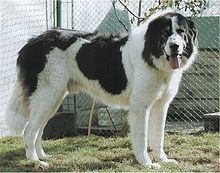The Romanian Bucovina Shepherd Dog (Romanian: Ciobănesc Românesc de Bucovina) is a breed of livestock guardian dogs native to the historical Bukovina (Bucovina) region. The breed is closely related to other livestock guardian breeds of the region, such as the Greek Shepherd, Tornjak, or Šarplaninac. There are four Romanian shepherd dog breeds: the Romanian Mioritic Shepherd Dog (old name Barac), the Carpathian Shepherd Dog (old name Zăvod), the Romanian Raven Shepherd Dog, and the Bucovina Shepherd Dog. In the FCI, this particular breed is officially dubbed the "Romanian Bucovina Shepherd".[1]
| Romanian Bucovina Shepherd Dog | |||||||||||||||||||||||||
|---|---|---|---|---|---|---|---|---|---|---|---|---|---|---|---|---|---|---|---|---|---|---|---|---|---|
 Romanian Bucovina Shepherd Dog | |||||||||||||||||||||||||
| Other names | Bucovina Sheepdog Bucovina Shepherd Southeastern European Shepherd | ||||||||||||||||||||||||
| Origin | Romania (Southeastern Europe) | ||||||||||||||||||||||||
| |||||||||||||||||||||||||
| |||||||||||||||||||||||||
| Dog (domestic dog) | |||||||||||||||||||||||||
History
editIt is a natural breed with its origin in the Carpathian Mountains (Romania). Special attention for the development of the breed arose in the regions of northeastern Romania, in the region of Bucovina, the well-known transhumance areas of the shepherds since immemorial times. Selection and improvement have led to the actual type. The breed is successfully used both for defending the flocks and herds and as watchdogs for households in the mentioned regions.[1]
The first standard was written in 1982 and updated in 2001 by the Asociația Chinologică Româna (Romanian Kennel Club). The present standard, dating from March 29, 2002, was written and updated according to the model established in 1987 by the FCI General Assembly in Jerusalem.[2]
In 2019, the Bucovina Shepherd Dog became definitely (fully) recognized by the FCI.[3]
Temperament
editThe Bucovina Shepherd Dog was bred to protect sheep flocks and cattle herds, and proves courageous and very combative when potential predators are afoot. It is an excellent watchdog, having a very deep, powerful bark and being very alert when strangers enter its territory.[1] During the night, it patrols around the property or herds. An adult Bucovina Sheepdog needs plenty of space to run around with a large back yard.
This breed is balanced, calm, very devoted, and loves children. It strongly mistrusts strangers.
Appearance
editLarge sized dog; commanding, haughty and proud.
Coat
editHead and the front part of the legs are covered with short hair. On the body, hair is abundant, long (6–9 centimetres (2.4–3.5 in)), hair is much longer forming a mane; on the backside of the forequarters, the hair forms fringes; on the backside of hindquarters, the hair is longer and forms culottes. The tail is bushy.[1]
Color
editMain colour of coat is a clear white or white-beige with distinct patches of grey, black or black with red-fawn reflections. Black or grey ticks can appear on the legs. Brindle aspect of patches to be rejected.[1]
Size
editThe male Bucovina Shepherd is 68–78 centimetres (27–31 in) tall. The females are close in size, at 64–72 centimetres (25–28 in).[1]
Conformation
editThe Bucovina Shepherd's head is massive, slightly elevated with respect to the back line. The skull is moderately wide. The stop is slightly marked. The nose is black well developed and wide. The muzzle has the shape of a truncated cone, of the same length as the skull, well developed. It becomes progressively narrow towards the extremity but it is never pointed.
The lips are thick, well applied, with strong pigmentation. This breed should have strong jaws, with healthy white teeth and a scissors bite. Level bite is allowed.
The cheeks are not prominent. The eyes are small in comparison with the dimensions of the skull, almond-shaped and slanting, chestnut colored or slightly lighter, never yellow.
Its eyelids are well pigmented. The ears are high, V-shaped, with rounded tips, fallen, and very close to the cheeks. The neck is moderately long, bulky and strong, without dewlap.
The muscular body is massive with a well-supported back. The chest is wide and tall, reaching the level of the elbows with well arched ribs. The skin is thick and dark gray. The hair is short on the head and forelegs. On the body, the hair is abundant, straight, thicker and harder, 2+1⁄2 to 3+1⁄2 inches (6–9 cm) long. The next layer of hair is shorter and thick, with a lighter color. On the neck, the hair is longer and forms a mane. On the backside of the legs, the hair forms fringes of moderate length.
The tail is bushy, covered with longer and thicker hair. When the dog is relaxed it tends to hold the tail low, reaching the point of the hock or even lower. When the dog is alert and is paying attention or is in action, the tail is elevated. In this case it may rise above the level of the back, sickle shaped.[1]
Gait
editHarmonious, elastic, well-coordinated, giving the impression of effortless power. The preferred gait is the trot.[1]
See also
editReferences
edit- ^ a b c d e f g h "Romanian Bucovina Shepherd" (PDF). FEDERATION CYNOLOGIQUE INTERNATIONALE.
- ^ "Provisional Basis Recognition" (PDF). Recognition of Breed. Fédération Cynologique Internationale. July 13, 2005. Archived from the original (PDF) on July 17, 2011. Retrieved June 23, 2007.
- ^ "Ciobanesc Romanesc de Bucovina". Fédération Cynologique Internationale. 2019. Retrieved May 4, 2019.